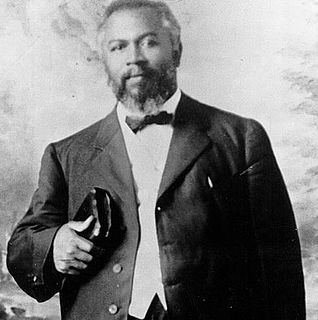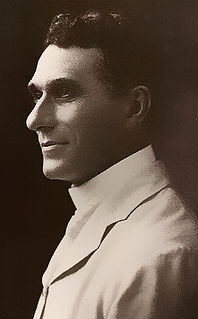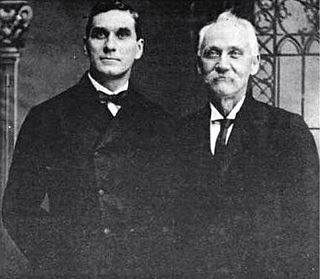
Pentecostalism or classical Pentecostalism is a Protestant Charismatic Christian movement that emphasizes direct personal experience of God through baptism with the Holy Spirit. The term Pentecostal is derived from Pentecost, an event that commemorates the descent of the Holy Spirit upon the followers of Jesus Christ, and the speaking in unlearned tongues as described in the second chapter of the Acts of the Apostles. In Greek, it is the name for the Jewish Feast of Weeks.
The Apostolic Faith Church, formerly the Apostolic Faith Mission, is a Holiness Pentecostal denomination of Christianity, with nationwide reach and headquartered in Portland, Oregon, United States. The Apostolic Faith Mission of Portland was founded in 1907 by Florence L. Crawford, who was affiliated with William J. Seymour and the Azusa Street Revival of Los Angeles, California. By 1908 Crawford had independently founded what would become the Apostolic Faith Church. Since July 2000, the Superintendent General of the Apostolic Faith Church has been Darrel Lee.
The Azusa Street Revival was a historic series of revival meetings that took place in Los Angeles, California. It was led by William J. Seymour, an African-American preacher. The revival began on April 9, 1906, and continued until roughly 1915. On the night of April 9, 1906, Seymour and seven men were waiting on God on Bonnie Brae Street, "when suddenly, as though hit by a bolt of lightning, they were knocked from their chairs to the floor," and the other seven men began to speak in tongues and shout out loud praising God. The news quickly spread; the city was stirred; crowds gathered; services were moved outside to accommodate the crowds who came from all around; people fell down as they approached, and attributed it to God; people were baptized in the Holy Spirit and the sick were said to be healed. The testimony of those who attended the Azusa Street Revival was "I am saved, sanctified, and filled with the Holy Ghost" in reference to the three works of grace of Holiness Pentecostals, the original branch of Pentecostalism. To further accommodate the crowds, an old dilapidated, two-story frame building at 312 Azusa Street in the industrial section of the city was secured. This building, originally built for an African Methodist Episcopal (AME) church, had more recently been used as a livery stable, storage building and tenement house. In this humble Azusa Street mission, a continuous three-year revival occurred and became known around the world. Stanley H. Frodsham, in his book, With Signs Following, quotes an eye-witness description of the scene: The revival was characterized by spiritual experiences accompanied with testimonies of physical healing miracles, worship services, and speaking in tongues. The participants were criticized by some secular media and Christian theologians for behaviors considered to be outrageous and unorthodox, especially at the time. Today, the revival is considered by historians to be the primary catalyst for the spread of Pentecostalism in the 20th century.

The Elim Pentecostal Church is a UK-based Pentecostal Christian denomination.

William Joseph Seymour was an African-American holiness preacher who initiated the Azusa Street Revival, an influential event in the rise of the Pentecostal and Charismatic movements. He was the second of eight children born to emancipated slaves and raised Catholic in extreme poverty in Louisiana.

Charles F. Parham was an American preacher and evangelist. Together with William J. Seymour, Parham was one of the two central figures in the development and early spread of American Pentecostalism. It was Parham who associated glossolalia with the baptism in the Holy Spirit, a theological connection crucial to the emergence of Pentecostalism as a distinct movement. Parham was the first preacher to articulate Pentecostalism's distinctive doctrine of evidential tongues, and to expand the movement.
Zionist churches are a group of Christian denominations that derive from the Christian Catholic Apostolic Church, which was founded by John Alexander Dowie in Zion, Illinois, at the end of the 19th century. Missionaries from the church came to South Africa in 1904 and among their first recruits were Pieter Louis le Roux and Daniel Nkonyane of Wakkerstroom who continued to evangelize after the Zionist missionaries left in 1908.
An African-initiated church (AIC) is a Christian church independently started in Africa by Africans rather than chiefly by missionaries from another continent.
The Zion Christian Church (ZCC) is one of the largest African-initiated churches operating across Southern Africa. The church's headquarters are at Zion City Moria in Limpopo Province, South Africa.

John Graham Lake was a Canadian-American leader in the Pentecostal movement that began in the early 20th century, and is known as a faith healer, missionary, and with Thomas Hezmalhalch, co-founder of the Apostolic Faith Mission of South Africa. Through his 1908–19 African missionary work, Lake played a decisive role in the spread of Pentecostalism in South Africa, the most successful southern African religious movement of the 20th century. After completing his missionary work in Africa, Lake evangelized for 20 years, primarily along the west coast of the United States setting up "healing rooms" and healing campaigns, and establishing churches. Lake was influenced by the healing ministry of John Alexander Dowie and the ministry of Charles Parham.

The Apostolic Faith Mission of South Africa (AFM) is a classical Pentecostal Christian denomination in South Africa. With 1.2 million adherents, it is South Africa's largest Pentecostal church and the fifth largest religious grouping in South Africa representing 7.6 percent of the population. Dr. Isak Burger has led the AFM as president since 1996 when the white and black branches of the church were united. It is a member of the Apostolic Faith Mission International, a fellowship of 23 AFM national churches. It is also a member of the South African Council of Churches.
Christianity is the dominant religion in Zimbabwe.

Christianity is the largest religion practiced in Zimbabwe, accounted for more than 84% of the population. The arrival of Christianity dates back to the 16th century by Portuguese missionaries such as Fr. Gonsalo Da Silveira of the Roman Catholic Church. Christianity is embraced by the majority of the population. It is estimated 85 percent of Zimbabweans claim to be Christians, with approximately 62 percent regularly attending church services. Christian faith plays a very important role in the organization of Zimbabwean society.

Thomas Hezmalhalch, usually known as Tom Hezmalhalch, was an American missionary, who together with John G. Lake founded the Apostolic Faith Mission of South Africa and was its first chairman and president. He was influenced by the healing ministry of John Alexander Dowie.
Pieter Louis Le Roux or PL Le Roux (1865–1943) was a South African missionary, who was a leading figure in the Zion Church movement in South Africa and the Apostolic Faith Mission of South Africa. Le Roux was initially a missionary for the Dutch Reformed Church. He was heavily influenced by the healing ministry of John Alexander Dowie and his Zionist movement which he later joined. Later he joined the Pentecostal movement of John G. Lake and Thomas Hezmalhalch. He was president of the Apostolic Faith Mission of South Africa from 1913 to 1942. His involvement with black leaders in South Africa led to the establishment of a conglomerate of churches from both Zionist and Pentecostal backgrounds, most notably the Zion Christian Church (ZCC).
Pentecostalism is a renewal movement within Protestant Christianity that places special emphasis on a direct personal experience of God through the baptism with the Holy Spirit. For Christians, this event commemorates the descent of the Holy Spirit upon the followers of Jesus Christ, as described in the second chapter of the Book of Acts. Pentecostalism was established in Kerala, India at the start of the 20th century.
Pentecostalism began spreading in South Africa after William J. Seymour, of the Azusa Street mission, sent missionaries to convert and organize missions. By the 1990s, approximately 10% of the population of South Africa was Pentecostal. The largest denominations were the Apostolic Faith Mission, Assemblies of God, and the Full Gospel Church of God. Another 30% of the population was made up of mostly black Zionist and Apostolic churches, which comprise a majority of South Africa's African Instituted Churches(AICs). In a 2006 survey, 1 in 10 urban South Africans said they were Pentecostal, and 2 in 10 said they were charismatic. In total, renewalists comprised one-fourth of the South African urban population. A third of all protestants surveyed said that they were Pentecostal or charismatic, and one-third of all South African AIC members said they were charismatic.
The doctrines and practices of modern Pentecostalism placed a high priority on international evangelization. The movement spread to Africa soon after the 1906 Azusa Street Revival in Los Angeles.
The Zion Apostolic Faith Mission Church is one of the earliest Zionist sects in southern Africa. It was formed out of a secession from the Pentecostal Apostolic Faith Mission in 1919, and attempted to create southern Africa's second "Zion City" in emulation of John Alexander Dowie. Although ZAFM was initially an influential church in Zionist circles, it failed to develop and prosper over the decades. It is best known today for spawning two secessions of its own that grew into large churches—the Zion Christian Church and the Zimbabwean Zion Apostolic Faith Mission.
Sarah Jane Lancaster was the leader of Australia's first Pentecostal congregation. An evangelist and administrator, she established a printing press in her meeting hall to produce evangelistic tracts and pamphlets. Lancaster also published Australia's first Pentecostal magazine, Good News. Lancaster became president of the nation's earliest attempt to organise Pentecostalism into a denomination, the Apostolic Faith Mission of Australasia. Although she is recognised as the founder of Australian Pentecostalism and contributed to the unique prominence of women in the founding of Australian Pentecostal congregations, many of her doctrinal ideas were quickly abandoned as the movement developed.







